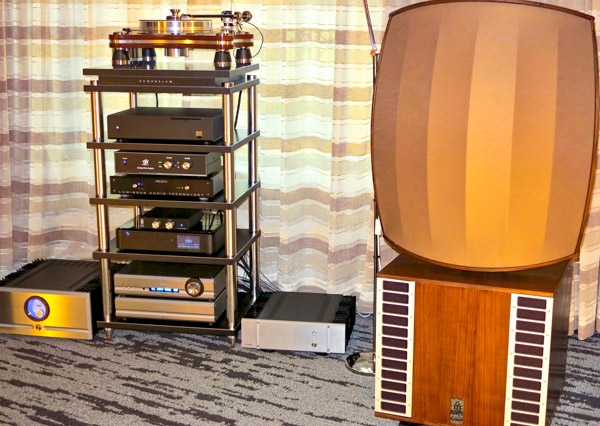| Columns Retired Columns & Blogs |
WAF-is very low

With 4 ohms nominal impedance and a claimed efficiency of 95-96dB for the array and 93dB for the woofer, the speaker should be able to perform well with just a few watts of power. Among other claims for the 175lb speaker—I have no reason to doubt that they are true—is that it’s flat off-axis, within 2.5dB over +/- 60°.
Some tracks on vinyl and CD sounded very good. Nonetheless, I thought the speakers too dynamic for the space they were in; their full potential went untapped. Regardless, the beauty of the music and the Pass electronics—XP22 preamplifier ($9500), XA25 power amplifier for the array ($4500), and X250.8 power amplifier for the bass ($7500)—shown through. Liquidity was a strong suit. This system is deserving of an audition in a more system-friendly environment.


A very modern speaker with a MCM design aesthetic.

If anyone might be interested in using panel exciters to build inexpensive distributed mode loudspeakers, here are links to a couple of interesting videos, and a link to a discussion thead.
This is not spam. I have no profit motive, no business affiliation.
Skip the first minute, related to another of his efforts.
http://www.youtube.com/watch?v=zdkyGDqU7xA
http://www.youtube.com/watch?v=CKIye4RZ-5k
http://techtalk.parts-express.com/forum/tech-talk-forum/64791-diy-flat-panel-speaker-love

DML distributed mode loudspeakers produce sound that varies from diffuse (chaotic, incoherent phase) at higher frequencies where wavelength is small relative to the radiating surface, and varies toward coherent phase at low frequencies where the radiating surface is small relative to radiated wavelength.
I think the technology might be better for secondary sources augmenting chaotic late arrival reflections in the reverberant field rather than for primary sources providing direct sound in a high quality playback system.
I also think that the non-directional diffuse nature of the technology might be useful in background audio systems and some types of professional sound reinforcement systems.

Are MBL type of speakers somewhat similar to what you are describing? :-) ..........

My understanding is…
MBL uses something similar to a conventional electrodynamic woofer motor attached to the end of the blade set, and on excursion of the motor it thrusts axially on the blade set which flexes the centers of the blades outward providing excursing displacement of the bladed driver. For each blade the ends are narrower than the middle, and the blades do not appear to have significantly varied thickness, so each blade will bend more nearer the ends and less nearer the middle (not a constant radius of curvature), which would cause broad area excursion on the blade radiating as a prolate spheroid rather than plain spheroid, which is more toward cylindrical than plain spheroid. The effect would be that measure of vertical polar response of that driver should show much higher SPL nearer the horizontal plane than the vertical plane. The varied blade width would also affect bending modes and any associated resonances.
While that varied axial thrust will induce modal flexure and resonance at higher frequencies, I think the design tries to avoid higher order bending modes in the blades, and that bladed driver would be low passed well below chaotic "break-up" modal resonances. I do not know if the blades include some constrained layer damping, but if they do that would reduce the power conversion efficiency. I expect that blade flexure at higher frequencies of the bladed driver pass band should be more like a textile dome tweeter at high frequencies, where the textile domes are designed to flex with low order bending modes, with coherent phase and not chaotic, without much chaotic breakup in the passband. Likewise the blades would be designed to flex with low order bending modes dominating the flexure.
That would be very different from modal resonance in a DML, which at higher frequencies is a diaphragm intentionally operating in breakup modal resonance … in the passband. Unlike the undesirable modal breakup resonances in a metal cone woofer, that breakup in the DML is utilized as a feature rather than a fault, is better managed for smoother usable response in that wideband breakup. The modal resonances become very complex, chaotic, with distributed phase, radiating non-directional diffuse sound, and therefore do not much interfere constructively or destructively with other sources, and so sum with other sources with largely uncorrelated phase at higher frequencies. You can see some of that in a conventional metal cone woofer by looking at off axis response in the breakup resonance frequencies, where the woofer beams with narrowed directivity below the breakup(s) and then radiation transitions into broad directivity in narrow band in the breakup modal resonances where local patches of diaphragm are radiating separately and chaotically. A good crossover for that woofer would trap the resonances and place those deep enough in the stop band in the low pass to make breakup resonances inaudible in the application. In the DML, that chaotic breakup is desired, and associated peaks can be smoothed by tweaking the panel geometry and the position of the panel exciters on the panel.

Seems like you are right about, the way MBL speakers' transducers work ........ Stereophile has reviewed MBL 101 model before ........ Some information about the way they work is described in the review along with the measurements :-) .........

... "outside Philadelphia PA" to audition these speakers?
http://mcaudiotech.com/
Is the Luminous Audio phono preamp still a current product?
https://luminousaudio.com/